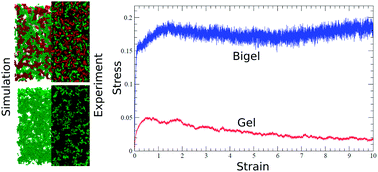Aggregation dynamics, structure, and mechanical properties of bigels
Abstract
Recently we have introduced bigels, inter-penetrating gels made of two different colloidal species. Even if particles with simple short-range isotropic potential are employed, the selective interactions enable the tunability of the self-assembly, leading to the formation of complex structures. In the present paper, we explore the non-equilibrium dynamics and the phenomenology underlying the kinetic arrest under quench and the formation of bigels. We demonstrate that the peculiar bigel kinetics can be described through an arrested spinodal decomposition driven by demixing of the colloidal species. The role played by the presence of a second colloidal species on the phase diagram, as expanded to account for the increased number of parameters, is clarified both via extensive numerical simulations and experiments. We provide details on the realisation of bigels, by means of DNA-coated colloids (DNACCs), and the consequent imaging techniques. Moreover we evidence, by comparison with the usual one-component gel formation, the emergence of controllable timescales in the aggregation of the bigels, whose final stages are also experimentally studied to provide morphological details. Finally, we use numerical models to simulate the bigel response to mechanical strain, highlighting how such a new material can bear significantly higher stress compared to the usual one-component gel. We conclude by discussing possible technological uses and by providing insights on the viable research steps to undertake for more complex and yet tuneable multi-component colloidal systems.


 Please wait while we load your content...
Please wait while we load your content...